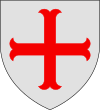Pyrmont county
|
Territory in the Holy Roman Empire |
|
|---|---|
| Pyrmont county | |
| coat of arms | |

|
|
| Alternative names | Principality of Pyrmont (from 1807) |
| Consist | 12th century until 1848 |
| Form of rule | monarchy |
| Ruler / government | Count, Prince
|
| Reichskreis |
Lower Rhine-Westphalian
|
| Dynasties | House Waldeck (from 1625) |
| Denomination / Religions | evangelical |
| Language / n | German , Low German |
| Residents | approx. 4500 (around 1800) |
| Incorporated into | Principality of Waldeck-Pyrmont
|
The county of Pyrmont was a territory in the Holy Roman Empire around the current city of Bad Pyrmont .
history
The Cologne Archbishop Philip of Heinsberg was in 1180 to protect the border of him in the overthrow of the lion Heinrichs acquired duchy of Westphalia at the Emmer the Burg Pyrmont build (Schellsburg) and gave to the Counts of Schwalenberg fief. The Counts of Pyrmont split off from this family in 1194. The first count was Gottschalk I (around 1171–1245). The counts had their seat in Lügde since 1376 . They died out with Moritz II in 1494.
The territory then fell to the Counts of Spiegelberg . These remained in the possession of the County of Pyrmont until 1557. The lords of Lippe followed as owners until 1583, then the Counts of Gleichen until 1625. It was under these that the Reformation was implemented in the county . Thereafter, the county fell to the Counts of Waldeck , who got into a protracted dispute with the Prince Diocese of Paderborn , because they denied a fiefdom of Pyrmont alleged by Paderborn. The Reich Chamber of Commerce ruled in 1668 in favor of the Waldecker. But in the same year there was a contract between the prince-bishop Paderborn and Waldeck, in which the office of Lügde was ceded to the bishopric. After Anton Ulrich von Waldeck was raised to hereditary prince status in 1711 , the sovereigns called themselves Princes of Waldeck and Pyrmont.
The county of Pyrmont belonged to the Lower Rhine-Westphalian Empire . Her counts were members of the Lower Rhine-Westphalian Imperial Counts College . As a result, the Counts of Waldeck had a seat and vote in both bodies after they came into possession of Pyrmont.
The area had around 4500 inhabitants around 1800. From 1525, Pyrmont Castle was the residence of the sovereigns. In addition to the castle and the town of Pyrmont, the county included ten villages. These formed an upper office and two Protestant parishes.
There were no estates in the county of Pyrmont (which was called the Principality of Pyrmont from 1807) . Only after the March Revolution of 1848 were Pyrmont MPs represented in the Waldeck-Pyrmont state parliament. Between 1848 and 1863/64 there was also a special state parliament in Pyrmont for the Principality of Pyrmont . This state parliament, consisting of five or eight members, had the right to budget for the Pyrmont state budget.
The constitutional unification of Waldeck and Pyrmont has been disputed since 1813. On January 28, 1814, Prince Georg Heinrich issued a constitution , the Organizational Edict . In this constitution, which came about without the participation of the estates or the people, he carried out the constitutional unification of the Principality of Waldeck with the Pyrmont, which has been known as the Principality since 1807. After massive protests from Waldeck, Prince Georg Heinrich had to confirm the renewed separation of Waldeck and Pyrmont in the Convention of July 3, 1814. It was not until 1849 that Waldeck and Pyrmont were united in one state. After the prince was deposed in 1918, the Free State of Waldeck-Pyrmont was established within the Weimar Republic.
Around 1921/1922 the Pyrmont district of Waldeck came to the Free State of Prussia . It now belonged to the province of Hannover and has been the district Hameln for the district of Hamelin-Pyrmont combined. Today the area belongs to Lower Saxony .
See also
literature
- Friedrich Keinemann: The Paderborn Monastery at the end of the 18th century . Bochum 1996, ISBN 3-8196-0405-7 (3 volumes).
- Gerhard Köbler : Historical lexicon of the German countries. The German territories from the Middle Ages to the present. 4th, completely revised edition. CH Beck, Munich 1992, ISBN 3-406-35865-9 , p. 483.
- Karl Theodor Menke: Pyrmont and its surroundings . Hameln / Pyrmont 1840. Digitized
Web links
Individual evidence
- ↑ Cf. Keinemann (1996), Vol. 2, p. 128: Only the right to fish and hunt was granted to the Count of Waldeck in the Lügde office. The Hochstift did not completely give up its claim to Pyrmont until its end and manifested this with the use of the Pyrmont coat of arms in the coat of arms of the principality.
Coordinates: 51 ° 59 ′ 0.8 ″ N , 9 ° 14 ′ 54.1 ″ E
